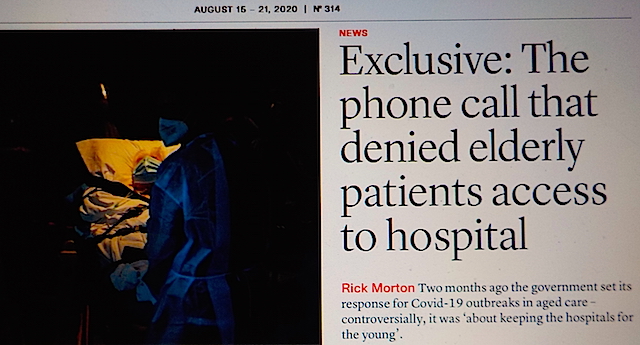Search
Recent comments
- quacks....
2 hours 15 min ago - niet...
6 hours 11 min ago - butt out bibi....
7 hours 40 min ago - progress....
7 hours 48 min ago - sergei karaganov....
9 hours 53 min ago - responsibility....
13 hours 37 min ago - the systems....
14 hours 15 min ago - the non-final solution....
18 hours 19 min ago - no intent....
1 day 2 hours ago - george in exile....
1 day 3 hours ago
Democracy Links
Member's Off-site Blogs
the phone call that denied elderly patients access to hospital...
- By Gus Leonisky at 18 Aug 2020 - 6:05am
- Gus Leonisky's blog
- Login or register to post comments

a national shame years in the making...
It’s an awful death too many Australians are facing: losing the battle to breathe against a relentless disease, alone but for medical staff, prevented from seeing and touching family and friends, unable to say farewell.
That’s been the fate of 71 people so far in aged care facilities, and likely many more before the Victorian outbreak is finally suppressed. It’s a number that represents over 40% of Australia’s COVID-19 death toll.
The outbreaks in more than half-a-dozen aged care facilities in suburban Melbourne involving nearly 700 patients come months after the deadly Newmarch House outbreak in Sydney that claimed 19 lives despite lockdowns of facilities.
The failure of Newmarch House managers to send ill residents to hospital has been raised as a key reason why the outbreak was so much deadlier there than in other facilities. The families of victims also complained they were banned from removing their ailing relatives from the residence.
Now the focus in Victoria is on aged care staff working at multiple facilities spreading the virus.
Last week, Minister for Aged Care and Senior Australians Richard Colbeck announced a funding package to enable operators to pay staff to work at single sites, and said the Victorian industry had begun “an urgent process to ensure aged care workers work in a single aged care facility where possible”.
“The industry will commence a cooperative process to identify existing workforce sharing and negotiate safer arrangements across the sector to minimise the risk of COVID-19 transmission in aged care.”
But one industry peak body claimed 20-30% of the aged care workforce work in more than one facility. For a sector employing around a quarter of a million people across Australia, that’s at least 50,000 people nation-wide.
Industry sources are telling the media they remain unclear about exactly how the scheme to end multiple work environments will work, while Colbeck is adamant that no worker should be working at more than one site now.
If the 20-30% figure is correct, it represents a large increase on a decade ago, when a Department of Health study of the aged care workforce identified 10% of the workforce as holding more than one job.
Notably, for around half of those who had more than one job, their other job wasn’t in residential care — it was in community care or outside the sector altogether, meaning the challenge for the industry isn’t merely consolidation of existing positions.
This is a heavily part-time workforce — in 2010, more than 90% of aged care workers other than registered nurses were part-time or casual; even 80% of nurses were part-time or casual, reflecting the heavily female composition of the industry.
At least one of the sites of the current outbreaks has serious questions over its compliance with standards, and has been evacuated, as have others, but workers brought in by the federal government were also apparently unqualified.
That is, once again the aged care workforce is at the centre of major concerns about the failings of the aged care system. The workforce is a recurring feature of the many inquiries that have been held into aged care over the last 20 years and more, including the horrific interim report from late last year of the aged care royal commission currently underway.
The issue has not been the lack of funding being pumped into aged care — that has expanded significantly, and gone into both residential care and home care. But private providers have been the main beneficiaries of that increased funding, and have increased their role in the sector at the expense of facilities run by religious groups.
Read more:
https://www.crikey.com.au/2020/07/28/aged-care-clusters-are-a-national-s...
disabled people feel they are expendable...
Australians with disabilities have suffered higher rates of domestic and family violence, are experiencing suicidal thoughts, and felt “expendable” during the Covid-19 pandemic, a royal commission has heard.
On Tuesday, the disability royal commission began a week of urgent hearings into the impact that coronavirus was having on people with disabilities.
Witnesses said it had exposed the issues with Centrelink payments, disability support, the community’s lack of understanding of disability, and terrifies people who feel they are expendable.
The chair of the royal commission, Ronald Sackville QC, said that despite the unprecedented Covid-19 pandemic, the commission would still meet its 30 October deadline to provide an interim report...
Read more:
https://www.theguardian.com/australia-news/2020/aug/18/covid-19-terrifie...
Read from top.